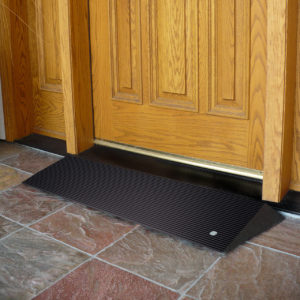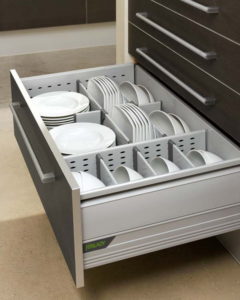Think your home is accessible?
Think again.
You may be surprised to find out how many barriers it contains and how inaccessible it really is.
Take the first steps toward a more accessible home by making improvements in the following areas.
Are you Making These Mistakes?
#1) Stairs into your home. Even one stair is a barrier. Create a level entry, install a ramp to your front door or even a side door so people using a wheelchair or those who have difficulty walking can get inside and enjoy your hospitality. Read more about integrating ramps or creating an accessible front entrance.
 #2) Narrow doorways. The opening of every doorway should be a minimum of 32in/81cm. If you can’t install wider openings take a look at offset hinges, which will widen the existing doorway by up to 2in/5cm.
#2) Narrow doorways. The opening of every doorway should be a minimum of 32in/81cm. If you can’t install wider openings take a look at offset hinges, which will widen the existing doorway by up to 2in/5cm.
#3) Door thresholds. Most exterior doors, and this includes sliding glass doors, have thresholds on them which create a tripping hazard and can prevent a wheelchair from getting through. A very simple solution is to make or buy ramps to install on both sides of the threshold.
#4) Round doorknobs. Using a doorknob requires the strength to be able to grip and turn, which can be difficult for some people, including young children, older adults and those with an injury. A lever handle can easily be operated by a fist or an elbow, which is helpful when your arms are full of grocery bags. Read more about how to improve the accessibility of doors.
#5) Missing grab bars. Statistics show that showers are dangerous places and that young and old alike, slip in this area. Greatly increase the safety in your bathroom and install at least one grab bar in the shower area and one beside the toilet. If your toilet is not in a corner, place a fold-down grab-bar on one side. Learn about the importance of grab bars.
#6) Incorrect toilet height. If you feel that your toilet is too low for you take a look at a ‘comfort height’ toilet. They’re about 17-19in/43-48cm tall (seat height), and many people find the slightly higher seat more comfortable to use, especially those with bad knees or hips or those of us who are tall.
#7) Knob faucet handles. Double faucet handles or knob-handles are difficult to use for people with limited hand mobility or if your hands are soapy and wet. Installing a single lever faucet makes it easy to achieve your perfect water temperature with one hand. Read how to create an accessible vanity area.
#8) Inaccessible shower. Make sure your shower has no dangerous curb/or lip to step over. You can achieve this by using channel drains which are flush with the floor and will make your shower accessible to everybody. Learn how to design the ultimate accessible shower.
#9) Fixed-shelf kitchen cabinets. You can retro-fit your existing fixed shelves with roll-out ones. By doing this you increase the accessibility of your cabinets and make it easier to find items at the back. If you are in the planning stage, install as many large deep drawers in your lower kitchen cabinets as possible. See 20 tips to accessible kitchen cabinets for more info.
#10) Poor lighting. Increase the levels of light in your house by adding extra fixtures such as floor or table lamps, and task lighting in areas where you work. Read more on how to have better lighting in your home.
Action Plan
Making these 10 changes to increase the accessibility of your home are the first steps toward improving the safety and comfort of your home. Upping the accessibility factor will help you prepare your home to be lived in for a very long time.
Receive a free accessibility checklist for your bathroom and kitchen by signing-up on our home page.



